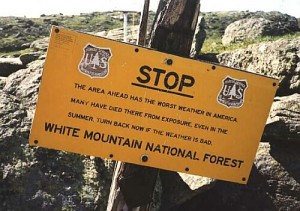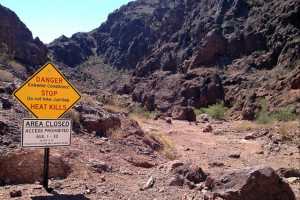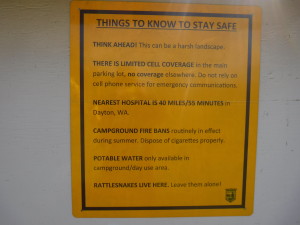While outdoor participants are routinely faced with mental “red flags” (or warning signs) either during the planning or conduct of an outdoor activity (such as a bad weather report), there are times when such red flags constitute actual warning signs which are confronted during the activity to make clear potentially catastrophic risks inherent in the activity. 
For instance, those familiar with hiking in the White Mountains of New Hampshire are well aware of the unpredictability of the weather. Warning signs which make clear such risks are posted at strategic locations along trails so that a hiker understands the need to exercise caution in the face of extreme cold weather conditions.
On the other end of the temperature spectrum, various trails in the western states (such as Arizona and Utah) pose hazards relating to excessive heat conditions. Warning signs are thus posted at strategic locations on such trails, again serving as warnings about proceeding in the face of such excessive heat conditions.

Despite such posted warnings about proceeding in the face of either of such temperature extremes, deaths have frequently followed.
Indeed, the National Park Service has been forced to close some trails during the summer months due to the failure of such warnings to be taken seriously by hikers. See, this notice.
And, those who climb New Hampshire’s White Mountains unprepared pay the price.
Warning signs are posted in such locales to warn against the foreseeable risk of potentially catastrophic weather conditions, and are an attempt to save the lives of those unfamiliar with such risks, or serve as a reminder to others. So, why do deaths still occur despite such warnings?

Human nature plays a role here. Factors such as overconfidence, an “it will not happen to me” view, calendar constraints, a failure to appreciate the magnitude of the risk to which the warning is directed, an overly optimistic time/activity plan, peer pressure, among others, may play a role, to the detriment of the participant.
It is important, when planning any activity, to appreciate not only the foreseeable risks of the planned activity, but the magnitude of such risks, so that either a rational “go-no go” decision may be made, or alternatively, that steps may be taken to mitigate the effects of such risks.
But, most importantly, when a participant is confronted with “a yellow sign”, it is best to pause to consider whether the planned activity is going to run contrary to the express warning provided. Is the participant “overreaching” in view of such information, such that a catastrophic end result is more likely than not? Indeed, one does not have to guess about potential foreseeable risks if they are clearly identified on a posted sign!
By way of a 2017 example, a family of four had to be rescued from Mount Washington (N.H.) when the trail became too difficult for the group to either proceed or return (son (31), mother (54), siblings (10 and 12)). As stated in the subsequent after-action report:
“It was determined through an interview that the hikers had intended to hike to the summit of Mt. Washington via Huntington Ravine trail. Belles had completed this hike several times before in the past and thought he could guide his mother and younger siblings through this difficult trail. In the process, the group noticed the signs placed by the U.S. Forest Service earlier in the season, warning hikers how difficult the trail was and to turn around if they were not prepared for the ‘most difficult trail in the White Mountains.’ They decided to continue on despite the warning.” (P.S. One person’s alleged preparedness does not always equate to everyone else, as demonstrated in this instance)
Warning signs should accordingly be considered a “gift” of information which information may be potentially critical to the safe conduct of the activity, which gift should be accepted and used with appreciation! Particularly when youth are involved!

P.S. Here is a warning sign the author came across at a state park in the state of Washington, which includes the warning “Rattlesnakes live here. Leave them alone”! Excellent advice.
